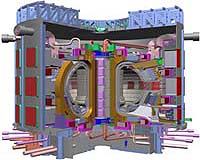 |
Buffalo NY (SPX) Jun 09, 2010 If battery-making is an art, then University at Buffalo scientist Esther Takeuchi is among its most prolific masters, with more than 140 U.S. patents, all in energy storage. Takeuchi developed the battery that made possible the first implantable cardiac defibrillators, a feat that was recognized last fall with the National Medal of Technology and Innovation from President Obama. Millions of heart patients worldwide have benefited from the implantable cardiac defibrillators powered by Takeuchi's silver vanadium oxide battery. With funding from the National Institutes of Health, she is developing new cathode materials for improved implantable cardiac defibrillator batteries, with her latest advances on this project recently published in the Journal of Power Sources. A slide show highlighting Takeuchi's biomedical research is available on YouTube: http://www.youtube.com/watch?v=Gm8MqA3u4MQ. But now Takeuchi is applying to the electrical grid - the vast, national network that delivers energy from suppliers to consumers - her unique perspective on how to coax the best performance out of battery chemicals. Having two years ago made the jump from industry to academia after 22 years, Takeuchi, a SUNY Distinguished Professor in UB's School of Engineering and Applied Sciences, may be just the scientist to find the right combination of materials that will usher in the next energy storage revolution. "Esther has a unique perspective," says Amy Marschilok, PhD, UB research assistant professor of engineering, who has worked with Takeuchi for more than six years. "In developing the silver vanadium oxide material that now powers the implantable cardiac defibrillator, she took an idea and turned it into a functional battery." "Now she's taking that experience and applying it to these very different areas," Marschilok continues. "Could a variation on one of the battery systems one day be applied to powering homes and buildings? That's the kind of perspective she has and it's what battery research really needs." In the past year, Takeuchi been awarded more than $1 million in funding by several federal agencies to develop better materials for batteries and ways to prevent their degradation. With a new project recently funded by the New York State Energy Research and Development Authority, Takeuchi and her husband, SUNY Distinguished Teaching Professor Kenneth Takeuchi, are developing new, low-cost materials for rechargeable batteries. The focus is on developing a distributed grid where renewable power is generated closer to where it's needed, rather than in a central place and transmitted long distances, the way the current grid operates. "One of the key challenges in moving from our fossil-fuel based system to greener, renewable forms of energy is that whether you're talking about solar or wind power, these forms of energy are intermittent," says Takeuchi. And even though the sun may be shining or the wind may be blowing, it's unlikely that either phenomenon will occur at a constant rate over time. "There will be fairly large fluctuations in the amount of power being generated," she says. That makes a robust, reliable method of storing energy absolutely critical. And it's a feature that has been essential in the life-saving biomedical devices Takeuchi has worked on in the past. "To generate energy at a usable, consistent level, we will need to couple a dependable, energy-storage system with renewable power sources," she says. Takeuchi's work on biomedical devices has provided her with an unusual appreciation for the properties of batteries that have exceptional longevity. The typical lifetime of a battery in an implantable device is 5-10 years and Takeuchi is one of those leading the push to increase that for both biomedical and utility applications. "Whether you're talking about the power grid, electrical vehicles or biomedical devices the quest is for low cost, longer life and rechargeability," she says. The University at Buffalo is a premier research-intensive public university, a flagship institution in the State University of New York system and its largest and most comprehensive campus. UB's more than 28,000 students pursue their academic interests through more than 300 undergraduate, graduate and professional degree programs. Founded in 1846, the University at Buffalo is a member of the Association of American Universities.
Share This Article With Planet Earth
Related Links Takeuchi's Biomedical Research Powering The World in the 21st Century at Energy-Daily.com
 Nomachine NX Enables ITER Organization To Work Towards Greener Energy
Nomachine NX Enables ITER Organization To Work Towards Greener EnergyRome, Italy (SPX) Jun 09, 2010 NoMachine NX plays an important role in ITER Organization's efforts to develop fusion energy, reducing the consumption of fossil fuels and damage to the environment. Established to develop a new, cleaner, sustainable source of energy, ITER Organization has become one of the largest and most ambitious worldwide science projects ever conducted. The Control Data Access and Communication ... read more |
|
| The content herein, unless otherwise known to be public domain, are Copyright 1995-2010 - SpaceDaily. AFP and UPI Wire Stories are copyright Agence France-Presse and United Press International. ESA Portal Reports are copyright European Space Agency. All NASA sourced material is public domain. Additional copyrights may apply in whole or part to other bona fide parties. Advertising does not imply endorsement,agreement or approval of any opinions, statements or information provided by SpaceDaily on any Web page published or hosted by SpaceDaily. Privacy Statement |